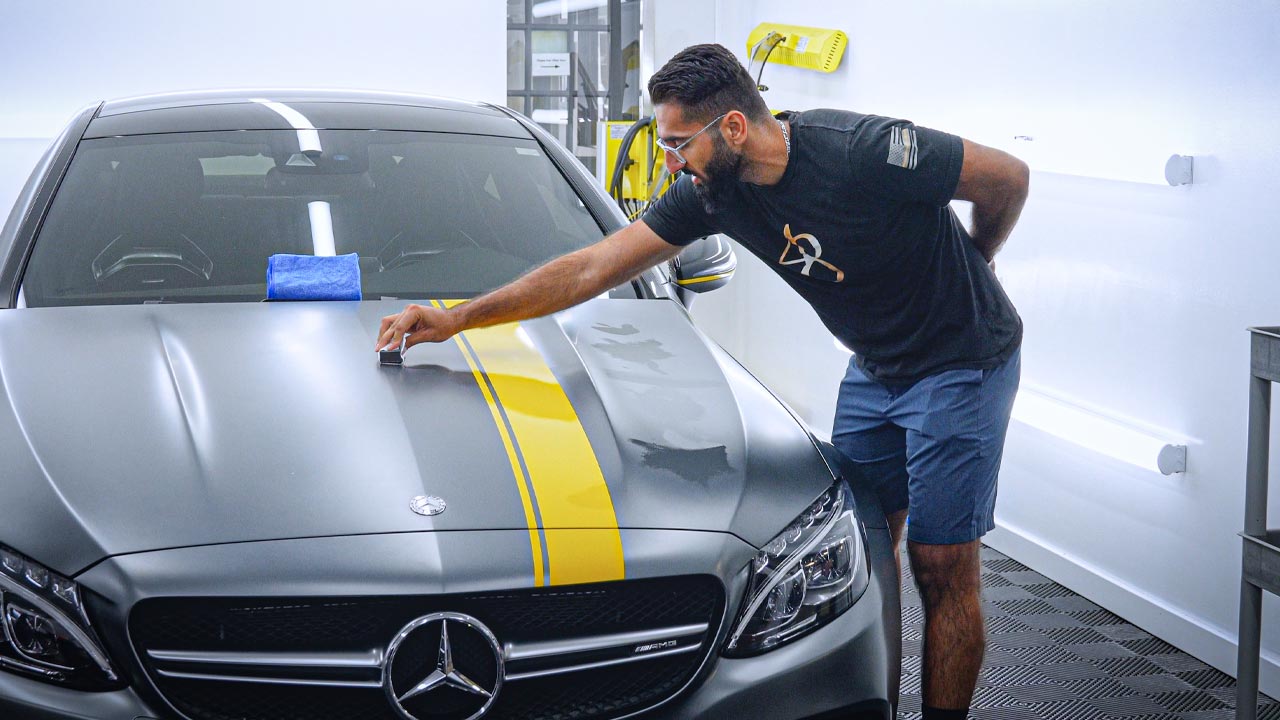How Describing Porcelain Finish Improves the Long Life of Your Car's Paint
Ceramic coating has actually arised as an essential innovation in automobile detailing, offering a long-lasting remedy for maintaining the honesty of your cars and truck's paint. Comprehending the complexities of how ceramic layer jobs and its benefits over traditional wax can offer useful insights for auto proprietors.
What Is Ceramic Finish?
Comprehending the protective advantages of ceramic finishing starts with identifying its make-up and performance. Ceramic covering is a fluid polymer put on the exterior surfaces of automobiles, mainly designed to improve and protect auto paint. The essential element of this covering is silicon dioxide (SiO2), which is originated from all-natural materials like sand. This substance forms a strong chemical bond with the factory paint, creating a protective layer that is both long lasting and hydrophobic.
The coating's application involves careful prep work of the automobile's surface area, which have to be totally free from impurities, scrapes, and flaws to make certain optimal attachment. Once applied, the ceramic finish treatments to develop an inflexible guard that can endure different ecological factors, including UV rays, chemical discolorations, and oxidation.
Furthermore, ceramic finishings are not simply surface-level therapies; they penetrate the paint to offer a long lasting defense. This capability extends the lifespan of the lorry's looks while maintaining its value gradually. Recognizing these basic aspects of ceramic coating is vital for car owners seeking efficient solutions for paint conservation and improvement.
Benefits of Ceramic Finish
The benefits of ceramic layer prolong far past its standard protective features - Conforti Auto and Marine Detailing Ceramic Coating. One of the most significant benefits is its capacity to provide exceptional durability. Unlike standard wax or sealants, ceramic finishes produce a strong bond with the cars and truck's paint, enabling it to endure environmental dangers such as UV rays, acid rainfall, and road salt. This durability substantially reduces the risk of paint damage, maintaining the lorry's visual charm.
Furthermore, ceramic finishes use hydrophobic residential or commercial properties, meaning they push back water and contaminants. This particular not just makes the vehicle easier to clean yet also lessens the frequency of washing, saving both time and initiative for vehicle owners. The slick surface area developed by the coating prevents dust and gunk from sticking, enhancing the automobile's total sanitation.
In addition, ceramic finishes enhance the depth and clearness of the paint, offering lorries a shiny finish that is aesthetically striking. This visual enhancement better adds to maintaining the automobile's resale worth, as a well-kept outside is a major selling point for potential purchasers. Generally, the benefits of ceramic finishing make it a worthwhile financial investment for any individual seeking to protect and boost their lorry's paintwork.
Exactly How Ceramic Finishing Works

The covering's hydrophobic homes fend off water and dust, protecting against the build-up of gunk externally. This not just makes the automobile easier to tidy yet likewise lowers the likelihood of scrapes and swirl marks caused by standard washing approaches. The ceramic layer acts as a guard versus UV rays, which can cause fading and oxidation over time.
As soon as cured, the coating shows amazing resistance to chemicals, consisting of road salts, bird droppings, and tree sap, which can otherwise harm the paint. The durability of ceramic coatings can last for numerous years, relying on variables such as maintenance and ecological conditions. On the whole, the chemical bonding process of ceramic coverings offers a robust protection that maintains the integrity and appearance of an automobile's paintwork.
Comparing Ceramic Finishing to Wax
Contrasting ceramic finish to standard wax discloses significant distinctions in performance and longevity. While both products aim to shield a car's paint, their structures and resilience established them apart. Wax, normally made from all-natural carnauba or artificial materials, gives a short-lived shield that usually lasts just a couple of weeks to a few months, depending on environmental conditions and upkeep regimens.
In comparison, ceramic finishes are sophisticated options composed of not natural products that bond chemically with the car's paint. This creates a robust, semi-permanent layer of protection that can withstand for a number of years. Because of this, ceramic finishings provide exceptional resistance to UV rays, chemical stains, next page and physical abrasion, dramatically decreasing the risk of oxidation and fading.
In addition, the hydrophobic residential or commercial properties of ceramic coatings ensure that water grains up and rolls off the surface area, making it much more difficult for dust and crud to adhere. This simplicity of cleansing is a noteworthy benefit over wax, which can attract dirt and call for regular reapplication. Ultimately, for auto owners looking for lasting defense and improved visual appeal, ceramic finishes provide a more reliable alternative to standard wax items.
Maintenance Tips for Durability
Correct maintenance is crucial for taking full advantage of the durability of a ceramic covering. Regular cleaning is the important link foundation of effective upkeep. Utilize a pH-balanced cars and truck shampoo to protect against deteriorating the layer, and stay clear of automated car cleans with rough brushes that can create micro-scratches. Instead, choose a touchless auto clean or hand wash.
To maintain the hydrophobic properties of the ceramic layer, take into consideration applying a maintenance spray or booster especially designed for ceramic finishings every few months. This will reinforce the safety layer and improve water beading.
Additionally, prevent subjecting the coated surface area to extreme ecological problems whenever possible. Car parking in shaded areas or using a cars and truck cover can stop UV damage and contamination from bird droppings, tree sap, or industrial fallout.
Last but not least, evaluate the finish regularly for indicators of wear or damage. If you notice a decline in hydrophobic behavior, it may be time for a specialist reapplication. By sticking to these upkeep tips, vehicle proprietors can substantially extend the life and effectiveness of their ceramic finish, ensuring that their auto's paint stays safeguarded and aesthetically appealing for many years ahead.
Conclusion
